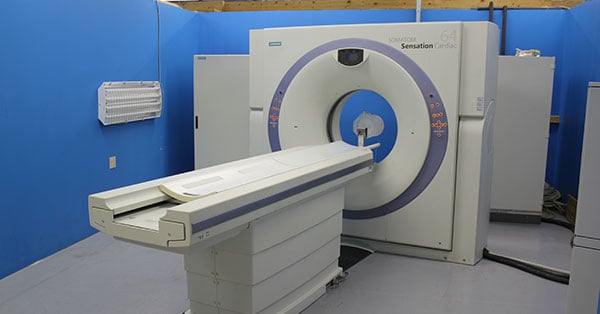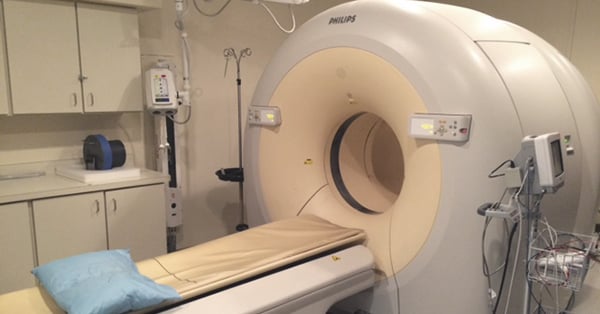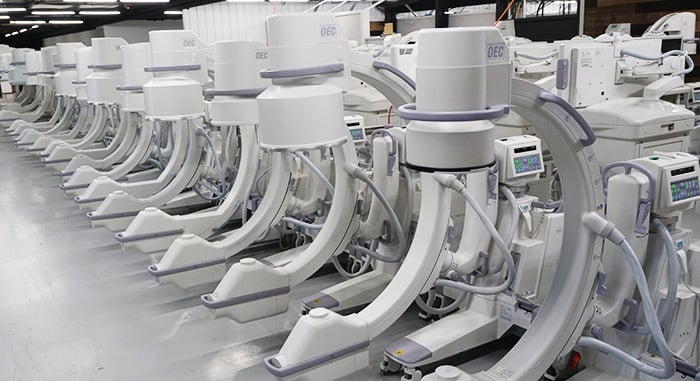
When it comes to 64-slice CT scanners, you won't find many names bigger than Siemens and Philips. Their Sensation 64 and Brilliance 64 scanners are popular models with solid availability in the secondary market. The Sensation and the Brilliance have a lot in common both functionally and in terms of the financial side of CT acquisition and ownership, and either can deliver high performance for physicians and patients alike. There are, however, a few finer details that set them apart from one another.
Below are key similarities and differences to think over as you consider the Siemens Sensation 64 and Philips Brilliance 64 as options in your 64-slice CT scanner search.
Already have a model in mind? Click here to see CT scanner inventory.
64 Slice CT Scanners Compared
What's the same?
Beyond the obvious (both of these are 64-slice scanners) the Sensation 64 and the Brilliance 64 have many other features in common. Here are a few of the big things they share:
- Similar tilt ranges
- Positioning laser lights
- Automatic mA control
- 512x512 reconstruction matrix (the Sensation is just a hair faster at 20 images per second vs. the Brilliance's 18)
- Automatic exposure control, or AEC (Siemens calls it CARE Dose 4D, Philips calls it DoseRight)
- Neither has 3D reconstruction
- The same relative price range for ongoing service coverage costs
- The same relative price range for initial system purchase
What's different?
There are plenty of finer points on which the Sensation and the Brilliance differ, but the biggest differences that will have an affect on any user from specialties to general use are:
Miscellania
- In terms of detectors, the Brilliance has 64 rows X 0.625 mm (40 mm coverage), whereas the Sensation 32/64 channels x 0.6 mm (19.2 mm coverage). Technically, the Sensation reads 32 slices two times from different angles, or 28.8 mm coverage with 32 rows at 0.6 and 8 rows at 1.2 mm.
- The Sensation has a smaller scan room size recommendation at 17.5 square meters vs. 19.95 square meters
- The Brilliance has motion correction in overscan while the Sensation has no motion correction
- The Sensation has a more powerful generator at 80kW high frequency vs. 60 kW High Frequency in the Brilliance
- The Brilliance has a longer table movement range (190 cm vs. 160 cm)
Cooling Systems
The Sensation is water-cooled, while the Brilliance is air-cooled. This means that a facility wanting to use a Sensation will need to install and maintain an external chiller to cool their systems. Of course, the choice between using an air-cooled system and a water-cooled system comes with its own set of pros, cons, and caveats. You can read more about all of those here: Air-Cooled CT Scanners vs. Water-Cooled CT Scanners
Tube Lifespan
In our experience with customers, industry partners, and our own engineering team we've seen an advantage in tube lifespan on the part of the Brilliance. The typical longevity we've observed is between 600,000 and 1,000,000 scan seconds for the MRC 800 tubes used in Brilliance scanners and 700,000 and 850,000 scan seconds for the Straton Z in the Sensation. Anecdotally, we have also seen MRC tubes last as long as 1.6 million scan seconds.
Tube Cost
Unlike their big competition, the GE VCT 64, both of these systems use only proprietary tube types. Because of this, both the Sensation and the Brilliance occupy a high tube replacement cost bracket. Still, some of the cost can be alleviated by purchasing used tubes from third-party suppliers. Here's the breakdown:
Siemens Straton Z:
- New from OEM- $210,000
- Lightly Used- $100,000-$115,000
- Moderately Used- $80,000-$90,000
Philips MRC 800:
- New from OEM- $193,000
- Lightly Used- $75,000-$85,000
- Moderately Used- $55,000-$65,000
Click here for more CT tube price ranges
XR-29 Compliance
For those who plan to use their scanner in the United States, you'll need to make sure it is compliant with XR-29 standards to avoid punitive cuts and be elligible for full reimbursement. Unless the last owner performed an upgrade, Brilliance 64 systems will need an XR-29 compliance solution from Philips. For some Brilliance scanners, this upgrade involves both software and about $75,000 in hardware. Siemens XR-29 upgrades are software-only.
The Takeaway
The Sensation 64 and the Brilliance 64 share a lot of similarities. On top of that, where one excels, the other offers some other, equally compelling attribute as a trade-off. Speaking holistically, neither system is a clear frontrunner over the other.
In the long run, based on our experience with both models, we'll say this: if your patient volume is moderate and your operating budget would be strained by adding chiller maintenance into the mix, the Brilliance 64 is probably a better pick for you. If you operate at a high patient volume and have the capital to spare for chiller coverage, we think the Sensation 64 is a better overall value,
Regardless of which model your needs may eventually draw you to, our team is ready to assist with your selection. Use the button below to tell us about your project and get the conversation started!

Jeremy Block
Jeremy Block is the Senior Vice President of Product Solutions at Block Imaging. Jeremy’s goal is to make your buying or selling experience as easy as possible. Outside of work, Jeremy enjoys Michigan State football, and spending time with his wife and kids.






